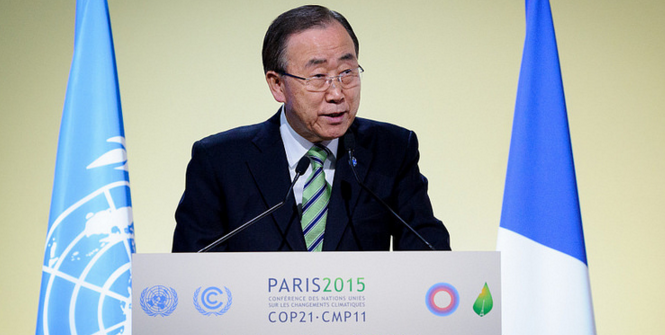Paris Climate Talks Slow to a Crawl as Obstructionists Threaten the Deal

Hopes are high that a strong climate treaty can be hammered out here in Paris, amid a groundswell of climate action around the world. But there is little sign of this urgency inside the negotiating halls themselves, and the talks have fallen into many of the same traps that befell the underwhelming Copenhagen summit six years ago.
Negotiators have spent the summit’s opening days working tirelessly to trim down the 54-page draft text of the Paris agreement into a shorter version to take into week two of the talks. The fact that the current text is still 48 pages long speaks volumes about the pace of the negotiations.
Each of the different sections of the draft agreement (climate finance, adaptation, emissions targets, and so on) are being worked on by numerous negotiating groups.
At any given time, there might be several smaller meetings taking place for different paragraphs, or even individual sentences, for each topic. The abundance of constant meetings is wearing negotiators ragged. Developing countries’ delegations, which are notoriously understaffed, have repeatedly complained of suffering from overstretch and exhaustion. But there is simply no other way forward.
Unfortunately, many issues have been going backwards. The discussion on legal form (whether the Paris agreement will be a legally binding treaty) is one example. Tuesday’s initial discussion of this issue lasted for more than three hours and resulted in a longer text with more disputed sections. This is by no means an exception.
The actions of certain delegations have contributed significantly to this. Saudi Arabia is traditionally known as an obstructionist in the climate talks. Its delegates have lived up to their reputation in Paris.
Bracketing text suggests that the wording is up for deletion, or is at least disputed. A Saudi negotiator will often briskly walk into a negotiating session, bracket some text, question the procedures, engage little thereafter, and leave before the session is closed.
Stalling tactics and bracketing numerous paragraphs across the agreement have been used to slow the negotiations to a snail’s pace.
Despite the wider political momentum on climate action outside these walls, the negotiations themselves tend to operate in a bubble. They are strangled by arcane procedures and old ideological battles.
Working a treaty
A key point of debate is whether or not the Paris climate agreement will be classed as an international treaty. It’s a delicate issue that has already threatened to stall the talks.
In one sense, this legal issue is very straightforward. A treaty, defined under the Vienna Convention, is an agreement that is binding under international law. So an agreement is either a treaty or not. This depends on some legal interpretation as there is no direct branding of an agreement as a treaty per se. A treaty is binding under international law, while an agreement only has political force.
Going into the negotiations, it seemed obvious that the Paris agreement would almost certainly be an international treaty. Countries’ climate targets would remain non-binding and nationally determined, but the agreement itself – including issues such as how often to review the targets – would be a treaty.
The opening days suggest that this may not be the case. The legal form of Paris is still very much up for grabs.
During the opening discussions Tuvalu wanted to insert text which would imply that the Paris outcome would be a treaty. But the United States expressed concerns and wanted to bracket Tuvalu’s suggestion. Saudi Arabia then suggested bracketing the entire paragraph.
Tensions flared, which is why the session lasted three hours and resulted in an even more complex and difficult piece of text.
This is coupled with last month’s declaration by US Secretary of State John Kerry that Paris would not result in a legal treaty. Paris, like Copenhagen, may not result in a legally binding deal. But of course, the negotiations are not over yet.
What’s the plan from here?
The negotiations are scheduled to end on Friday December 11. The plan is to have a final draft of the agreement prepared much earlier than that – ideally by the summit’s middle weekend. The key undecided issues will then be worked out during the early stages of the second week, during the “high-level” sessions attended by ministers.
The finalised agreement will then be agreed on Thursday 10 December and legally adopted the following day, after which negotiators will crack open the champagne before returning home triumphant on the Saturday.
That’s the plan – but it will almost certainly not pan out like that.
What will really happen?
The text is supposed to be handed over today, but at the current rate, the negotiations may need an extra day or two to produce a suitable draft.
The current draft is almost certainly too controversial and unwieldy to be worked out quickly over a few days, and rumours abound that the French host delegation is preparing its own alternative text should the negotiations stall completely.
However, the arrival of ministers on Monday could help to shift the talks forward. Or it could simply entrench the existing negotiating positions, and lead to lowest-common-denominator compromises being made at the last minute.
In the worst-case scenario, the planned treaty could give way to collapse or a smaller agreement between the major powers. If that happened, we would be staring down the barrel of another Copenhagen.
Luke Kemp is a lecturer and PhD Candidate in International Relations and Environmental Policy at the Australian National University. This article was originally published on The Conversation on 5 December. It is republished with permission.





